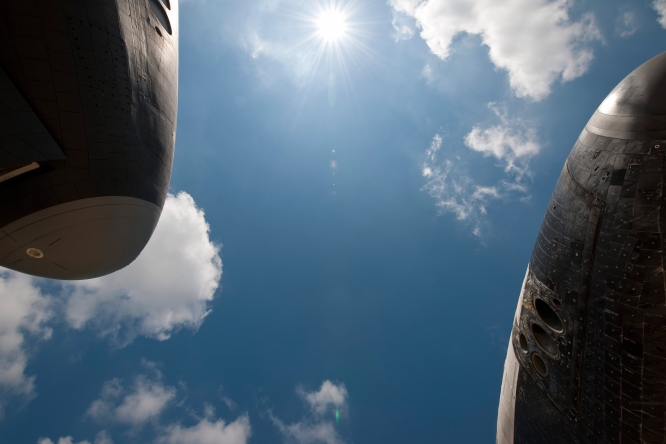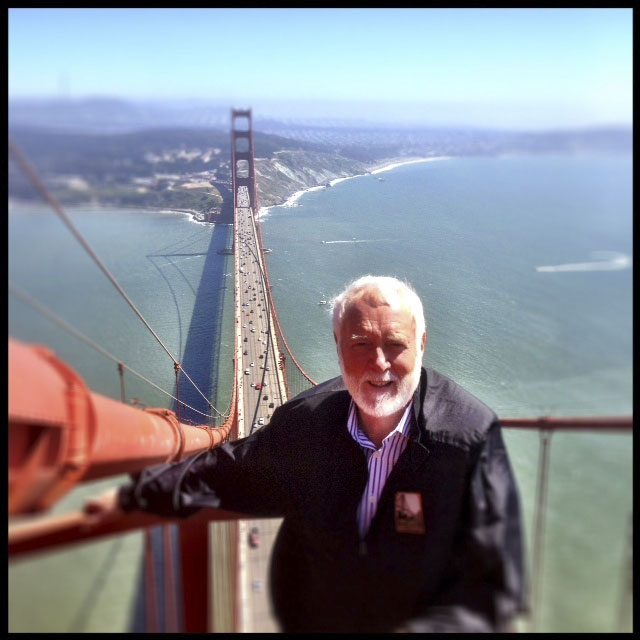A golden opportunity
A Golden Opportunity
“My arms are flung across the deep, into the clouds my towers soar.” It’s not often that an engineer waxes poetic, but these were the words of the Golden Gate Bridge’s chief engineer Joseph Strauss. Educated as an engineer and a bridge builder by trade, he loved poetry, having been named “class poet” when he graduated from the University of Cincinnati in 1892. Strauss was driven and flawed, but he managed to overcome a host of obstacles and build what is known today as the “world’s most beautiful bridge” with its distinctive International Orange color.
And what a bridge he built. Set where the Pacific Ocean crashes into a rocky coastline, often cloaked in fog, lying a short distance from the mighty San Andreas Fault, and standing 400 feet above the rapid tides that course through the Golden Gate, its presence is regal and serene. My lifelong love affair with the Bridge began when I was a Ph.D student at Cal Berkeley in the 1960s and was later enhanced when I taught at Stanford and my wife and our family used anniversaries and birthdays as excuses to walk across it. So when I got a call about a year ago from Denis Mulligan, General Manager of the Golden Gate Bridge Authority, asking if I would keynote one of the events celebrating the 75th anniversary of the Bridge’s completion, I couldn’t wait to say yes!
Fast forward to June 21. A tiny elevator whisks me and Denis to the top of the North Tower of the Bridge, 780 feet above the cold Bay waters, where a spectacular view of San Francisco and the Marin Headlands unfolds. Twenty- to 30-mile-per-hour mph wind gusts demonstrate the wisdom of holding on. It was a tremendous conclusion to a visit during which Denis treated me to a view from inside the foundation where great cables and anchors stabilize the massive structure against traffic, winds, and earthquakes. He also showed off the new visitors’ center, a repository of the Bridge’s history as well as a collection of experiential exhibits which teach the essential science and engineering lessons of the Bridge. I particularly loved seeing the massive shock absorbers which dampen the impact of earthquake loads.
This fit right into my keynote address about the ways in which we can use great public works projects like the Golden Gate Bridge to inspire learning. Education lies at the heart of the Smithsonian’s mission, and the need for it has never been more pronounced.
Falling Behind
In 2009, an assessment by the Organization for Economic Co-operation and Development assessment measured the level of preparation of students around the globe. The results provided a wake-up call for the United States. Among the 34 OECD countries, 15-year-old American students ranked 14th in reading proficiency. In science, scores rose from previous years, but only to 17th place. In math, the results were even more disheartening with a 25th place showing. In an era of global competitiveness, those numbers have serious economic consequences.
A 2009 McKinsey and Company report detailed that achievement gaps in race, income, and regions and systems siphon as much as 30 percent of GDP from our economy. The report likened it to a “permanent national recession.” The Smithsonian has a responsibility to use its experts in history, science, culture and art to help bridge these education gaps. Secretary Joseph Henry knew this in 1850 when he wrote, “The worth and importance of the Institution are not to be estimated by what it accumulates within the walls of its building, but by what it sends forth to the world.”
Smithsonian Sparks Curiosity
Beautiful, larger-than-life human endeavors have a special knack of capturing people’s imagination, whether the Golden Gate Bridge or one of the many landmarks here in the nation’s capital. Among the Smithsonian’s 137 million objects are pieces or representations of these impressive projects. Artist Ray Strong’s 1934 painting of the construction of the Golden Gate Bridge, in the collection of the Smithsonian American Art Museum, was more than artistic expression—it so powerfully symbolized American ingenuity and innovation that President Franklin Roosevelt later displayed it in the White House. The National Museum of American History has an 800-pound steel pintle ball responsible for supporting a 600-ton steel gate that provided ships passage through the Panama Canal. The sheer mass of this artifact helps us speak to the unprecedented effort required to dig nearly non-stop for nine years, overcome unbelievable obstacles, and achieve the largest civil engineering feat in U.S. history. And of course, Space Shuttle Discovery touched down at its new home at the National Air and Space Museum’s Steven F. Udvar-Hazy Center in April 2012, a testament to the efforts of thousands of people all across the country. They embody America’s most noble idea that together, we can make our dreams take flight, no matter the obstacles in front of us.

Space Shuttles Enterprise, left, and Discovery meet nose-to-nose during the a transfer ceremony at the Smithsonian’s National Air and Space Museum Steven F. Udvar-Hazy Center, Thursday, April 19, 2012. (Photo by NASA/Bill Ingalls)
Tomorrow’s Smithsonian Today
Discovery provides a good example of how iconic objects can tell the stories that engage people in learning. We are developing a Learning Lab at the Udvar-Hazy Center that will provide students with hands-on activities, videos, and class work centered on the engineering and science of Discovery. A Shuttle Discovery Station will feature interactive objects and demos, and our ¾ scale Discovery Flight Deck Simulator allows visitors to try their hand at landing the Space Shuttle. Looking back to another time, NMAI is using the story of the Inka Road to illustrate the remarkable engineering prowess of the people of the Inka Empire. 600 years ago the Inka, without wheeled vehicles and iron or steel tools, built a road system that stretched 20,000 miles over the Andes Mountains and through the jungles of the Amazon. That these roads and the accompanying agricultural terraces and structures are still here today is a testament to the prowess of the Inka builders. NMAI’s research will culminate with a large exhibition in 2015.
Let’s Top Ourselves
The Smithsonian is at its best when it occupies the nexus of creativity and scholarship, left and right brain working in tandem. I have seen it to an unprecedented extent in the last year, where your creativity, passion, and persistence have been on display with showcases like Titanoboa, The Art of Video Games, African Cosmos, Math Alive!, and Song 1. You are becoming more connected, sharing ideas with colleagues through the Consortia, through the Palmer Leadership Development Program, and even through Yammer! The Smithsonian is being transformed before our eyes.
Grateful Dead percussionist Mickey Hart, who collaborated with Smithsonian Folkways to release the Mickey Hart Collection, translated seismic data from the Golden Gate Bridge into music, creating a unique soundscape for the 75th anniversary of the bridge. Hart noted of the inspiration, “The bridge connects. It links space and place above, below and across. It spans landscape and memory; it joins life and lore.” The Smithsonian can do the same. I urge all of you to continue to look at your collections, your programs, and your research in new ways that will spark lifelong learning.
Posted: 29 June 2012
- Categories:





Wow, nice image! Climbing to great heights for the sake of an educational goal–pretty great stuff.
Its amazing seeing Secretary Cloughs posing for a picture on the Golden Gate Bridge cables. I have the same passion for spending time in San Francisco and walking across the Golden Gate Bridge. The scene is breath taking.